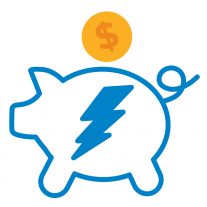Dynamic Pricing 101: Beat the Heat and High Utility Bills
![]() Did you know that Ameren Illinois and ComEd offer two rate options? Many ratepayers are unaware of their choices when it comes to what they pay for electricity. If you’re familiar with Elevate, however, you
Did you know that Ameren Illinois and ComEd offer two rate options? Many ratepayers are unaware of their choices when it comes to what they pay for electricity. If you’re familiar with Elevate, however, you ![]() may know that we administer both Ameren Illinois’ Power Smart Pricing program and ComEd’s Hourly Pricing program. These hourly pricing programs allow participants to pay hourly, market-based prices for electricity rather than the standard fixed rate. With these programs, shifting electricity usage to lower priced hours can lower residential electric bills.
may know that we administer both Ameren Illinois’ Power Smart Pricing program and ComEd’s Hourly Pricing program. These hourly pricing programs allow participants to pay hourly, market-based prices for electricity rather than the standard fixed rate. With these programs, shifting electricity usage to lower priced hours can lower residential electric bills.
What’s the difference between these rate options?
With Ameren and ComEd’s standard fixed-price rate, customers pay the same price for electricity no matter what time of day or which day you use it. It does not change from hour to hour or from day to day.
With Ameren and ComEd’s hourly pricing programs, the price of electricity varies from hour to hour and day to day according to the actual market price. The programs are designed to help households save on energy costs by being smart about how and when they use energy.
How are hourly prices set?
Ameren Power Smart Pricing uses hourly market prices which are set by MISO—the Midcontinent Independent System Operator, Inc. ComEd’s Hourly Pricing program gives you access to hourly electricity prices that are based on the Residual ComEd Zone PJM wholesale market prices. Ameren and ComEd do not mark up or profit from the price of electricity; customers simply pay the market price.
How does weather impact hourly prices?
Hourly, market-based electricity prices typically change as the demand for electricity changes; higher demand usually means higher hourly prices. This means that as the seasons change, hourly pricing participants can expect changes in the typical hourly electricity price pattern.
During the summer, electricity prices tend to be highest in the late afternoon, particularly on hot days when air conditioning use drives up the demand for electricity. Summer prices are typically lower during off-peak times such as nights and weekends.
Compared with summer prices, average fall, winter, and spring prices are generally lower, and the price pattern is more stable. During the cooler months, there tends to be a small price spike in the morning and then again in the evening.
![]()
How can I get the most out of hourly pricing during the summer?
As summer heats up, we’ve rounded up a few small changes that can help you save money and stay comfortable. As a general rule of thumb, to manage summer electricity costs, reduce your usage between 1 p.m. and 5 p.m. on weekdays, particularly on hot days, and shift some of your usage to nights and weekends.
Air Conditioning
Change your thermostat to a warmer setting when electricity prices are high and when you are away from home. To stay cool and cut costs, pre-cool your home at night when electricity prices tend to be low.

- Set window air conditioners to the low or “energy-saver” setting, or turn them off when electricity prices are high.
- Use fans along with or instead of your air conditioner. Fans use far less electricity than air conditioners. Fans could allow you to raise the thermostat setting 4° with no reduction in comfort (U.S. Department of Energy).
Laundry
- Wash your laundry in cold water and when electricity prices are lower. You’ll save on water heating and electricity.
- Make sure the dryer doesn’t run longer than needed, or use a clothes line or drying rack to avoid spending a dime on energy.
Kitchen
- Avoid using ovens and stoves during high price times. A microwave will heat small portions more efficiently. Enjoy no-cook meals or grill outside to avoid heating up the kitchen on hot days.
- Run the dishwasher when electricity prices are lower, use the energy-saver or no-heat dry setting, and only run full loads of dishes.

While enjoying the benefits of those extra dollars on the most important summer purchase—ice cream—instead of cooling your home, hourly pricing also helps protect the environment. By reducing electricity use during peak demand times, especially in the summer, we reduce the need to build or operate additional power plants, which helps lower greenhouse gas emissions. Shifting electricity use helps ease stress on the power distribution system, making electric service more reliable in our communities.
Resources to Help You Save
Click here to download seasonal energy guides for ComEd’s Hourly Pricing program and Ameren Illinois Power Smart Pricing.



